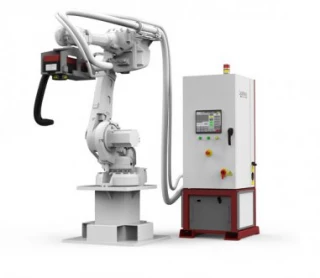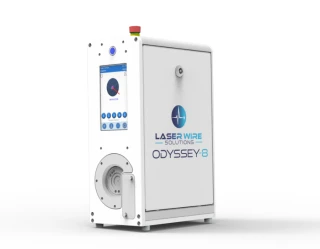Laser Cleaners
Frequently Asked Questions
Are laser cleaners safe?
Yes, laser cleaning is safer for operators and employees than other surface cleaning methods, such as sandblasting or dry ice blasting. It generates no additional waste and is environmentally friendly. It is also non-damaging and non-conductive, so it's safe for the material you're cleaning.
Will Laser Cleaners work on all objects?
Although laser cleaning is one of the most effective methods for removing contaminants from metals and nonmetals, it is not appropriate for all projects. Larger surface areas may take longer to clean and may not produce the desired results because laser technology works best for small, targeted areas.
How much does a laser cleaner cost?
The cost of a 1000W handheld laser cleaning machine begins at $8000. The price for higher power machines come run up much higher depending on the output parameters. Sophisticated laser cleaning machinery might run upwards of $100,000
Is laser cleaning expensive?
Yes and no. While the upfront cost of investment into the machinery might high, compared with other cleaning technologies, laser cleaning can save big time in the long run on consumable, environmental costs etc. So, if you are an occasional user the technology might not be for you but if you are consistent user, you might give it a serious consideration.
What can you clean with a laser cleaner?
With laser cleaners you can clean a wide variety of materials from metal to nonmetal. Laser cleaners can effectively remove various contaminants such as rust, grease, mold, oil, paint, etc. Most suppliers list both the applications and applicable materials for the equipment they sell. If in doubt always contact the supplier.
How fast is laser cleaning?
The speed of laser cleaning is determined by the laser system and settings, the contaminant, the geometry and the thickness of the coating to be removed. The maximum cleaning rate would be approximately four-square feet per minute per mil (.001") of coating thickness.
Can laser cleaning remove paint?
Laser cleaning is typically used for removing rust, grease, oil, hazardous paint, and other contaminants that can impact your product.
What types of lasers are used in typical laser cleaners?
Laser cleaning requires a pulsed fiber laser (typically 50 watts or more).
Does laser cleaning remove metal?
Laser rust removal, a type of laser cleaning, is an effective process for cleaning up metal parts.
Laser Cleaners: A Revolution in Surface Treatment
Laser cleaning technology has emerged as a groundbreaking solution in the realm of surface treatment, offering a non-contact, eco-friendly, and precise method for removing contaminants from various materials. Unlike traditional cleaning methods that rely on abrasive materials or chemical solvents, laser cleaning utilizes focused laser beams to ablate unwanted substances without damaging the underlying substrate.
Understanding Laser Cleaning Technology
At its core, laser cleaning operates on the principle of laser ablation. High-intensity laser pulses are directed at a surface to remove contaminants such as rust, paint, oxides, and residues. The laser energy is absorbed by the surface layer or contamination, causing it to evaporate or break away cleanly. This highly controllable process enables selective cleaning, ensuring that only the undesired materials are removed without affecting the base surface.
Key Advantages of Laser Cleaning
1. Non-Destructive: Laser cleaning preserves the integrity of the base material, making it ideal for delicate or high-value components.
2. Eco-Friendly: This method eliminates the need for chemical solvents and abrasive media, significantly reducing environmental impact.
3. High Precision: Laser parameters can be precisely controlled to target specific contaminants, including from complex or fine-featured surfaces.
4. Cost-Effective: Reduced need for consumables and lower maintenance requirements translate to long-term operational savings.
5. Safer Work Environment: With fewer chemicals and reduced airborne particulates, laser cleaning contributes to safer working conditions.
Applications Across Industries
Laser cleaners are used in a wide range of industrial and scientific applications due to their versatility and efficiency:
-
Automotive: Removal of rust, old coatings, or adhesives from parts and components prior to welding or finishing.
-
Aerospace: Cleaning of aircraft engine components and structural parts, where precision and surface integrity are paramount.
-
Electronics: Removal of flux residues or surface contaminants from PCBs without damaging delicate circuits.
-
Cultural Heritage Preservation: Gentle removal of pollutants, oxidation, or biological growths from historical artifacts or stone monuments.
-
Manufacturing: Maintenance of molds, dies, and tooling surfaces by eliminating residues and build-up, improving production quality.
Laser Cleaning System Types
There are two primary types of laser cleaning systems:
-
Pulsed Laser Cleaners: Ideal for precision cleaning applications, pulsed systems deliver energy in short bursts to remove contaminants with minimal heat transfer.
-
Continuous Wave Laser Cleaners: Better suited for industrial-scale or heavy-duty cleaning tasks where more power and sustained laser output are required.
The choice between these systems depends on the type of material, contamination, and operational requirements.
Key Considerations for Adopting Laser Cleaning
Before integrating laser cleaners into your workflow, consider:
-
Material Sensitivity: Some surfaces, like plastics or polished metals, may require fine-tuned settings to prevent surface alteration.
-
Contaminant Type and Thickness: Different contaminants (e.g., oxides vs. grease) respond differently to laser energy. Adjustments in wavelength, pulse duration, and power are key.
-
Portability vs. Automation: Depending on the application scale, users may choose between handheld units for flexibility or fully automated systems for high-volume production.
The Future of Laser Cleaning
Laser cleaning continues to gain momentum as industries seek cleaner, faster, and more sustainable surface treatment solutions. Advances in laser source technology, beam delivery systems, and software integration are making laser cleaning more affordable and accessible to a wider range of users.
As regulations become stricter on the use of chemical solvents and waste generation, laser cleaning presents a modern, responsible, and forward-looking alternative. Its adoption is set to expand across industries ranging from aerospace and defense to energy, electronics, and even fine arts.


